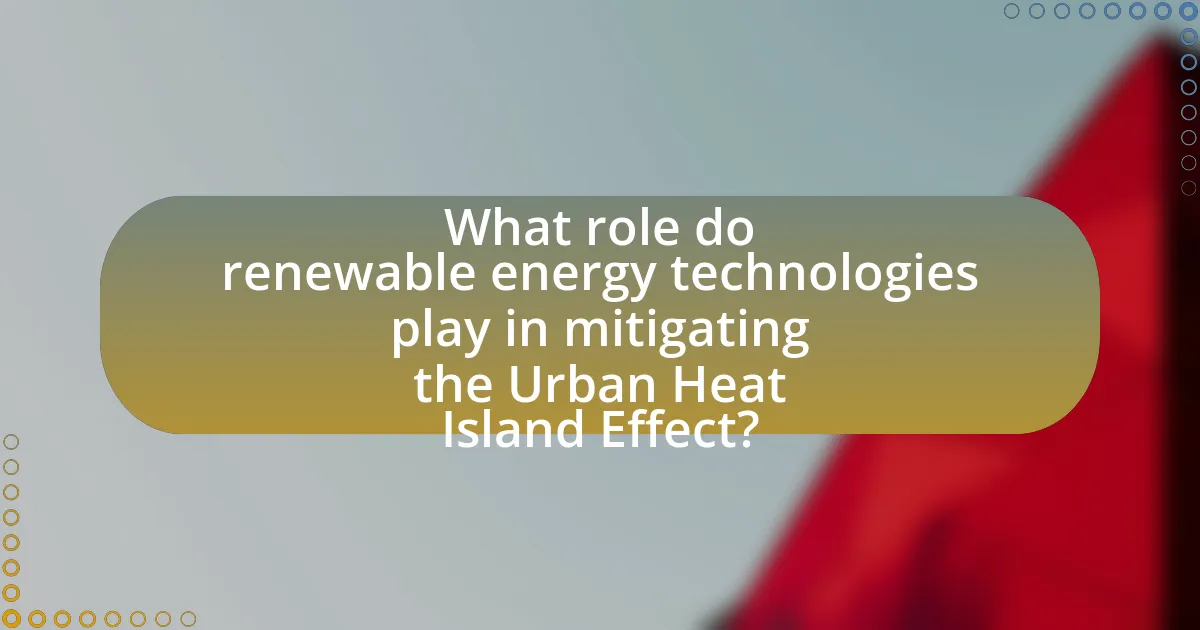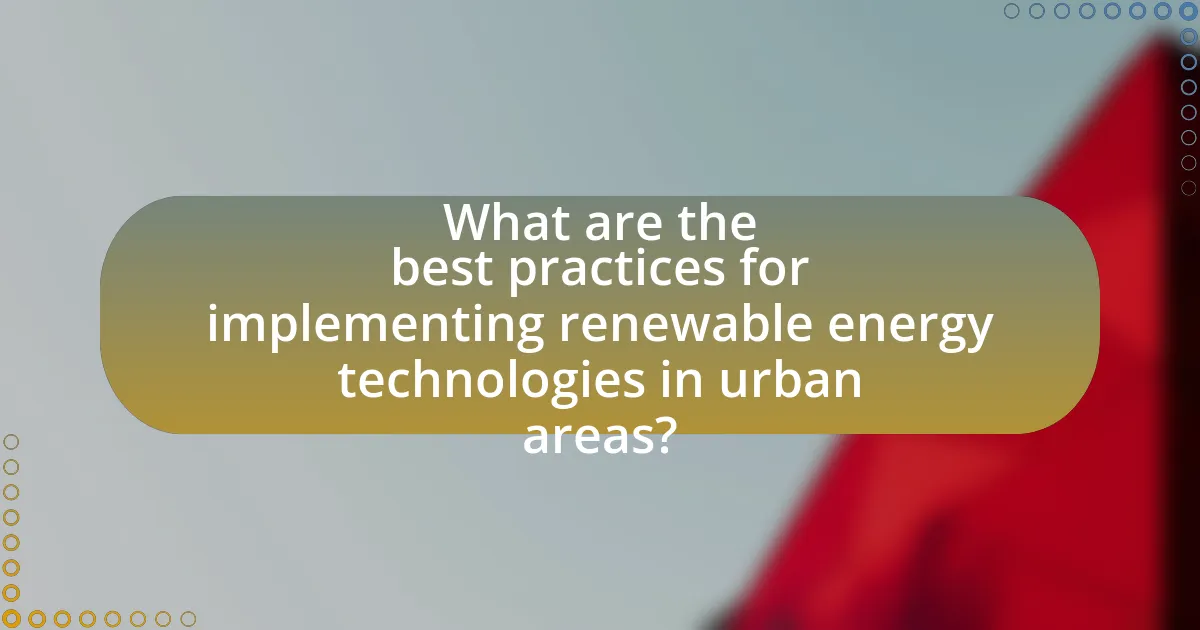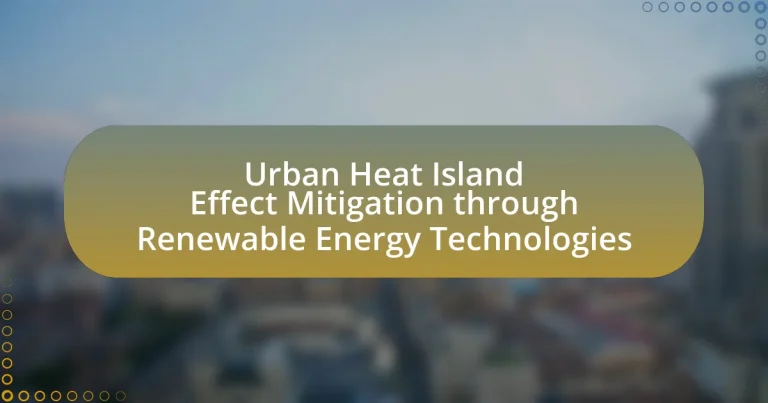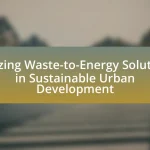The Urban Heat Island Effect refers to the phenomenon where urban areas experience higher temperatures than their rural counterparts due to human activities and land modifications. This article explores the causes and impacts of this effect, highlighting how urban infrastructure, reduced vegetation, and increased energy consumption contribute to elevated temperatures. It emphasizes the importance of mitigating the Urban Heat Island Effect through renewable energy technologies, such as solar, wind, and geothermal energy, which can lower urban temperatures, reduce energy demand, and improve public health. Additionally, the article outlines best practices for implementing these technologies and the challenges cities face in addressing this environmental issue.

What is the Urban Heat Island Effect?
The Urban Heat Island Effect is a phenomenon where urban areas experience significantly higher temperatures than their rural surroundings due to human activities and modifications to land surfaces. This temperature difference arises from factors such as the concentration of buildings, roads, and other infrastructure that absorb and retain heat, as well as reduced vegetation and natural land cover. Studies indicate that urban areas can be up to 5 to 10 degrees Fahrenheit warmer than nearby rural areas, particularly during summer months, which can exacerbate energy consumption, air pollution, and heat-related health issues.
How does the Urban Heat Island Effect impact urban environments?
The Urban Heat Island Effect significantly raises temperatures in urban environments compared to surrounding rural areas. This phenomenon occurs due to human activities, such as the extensive use of concrete and asphalt, which absorb and retain heat. Research indicates that urban areas can be 2 to 5 degrees Fahrenheit warmer than their rural counterparts, leading to increased energy consumption for cooling, elevated emissions of air pollutants, and heightened heat-related health risks. For instance, a study by the U.S. Environmental Protection Agency found that urban heat islands can increase energy demand for air conditioning by 10 to 30 percent during peak summer months.
What are the primary causes of the Urban Heat Island Effect?
The primary causes of the Urban Heat Island Effect are the extensive use of concrete and asphalt, which absorb and retain heat, and the reduction of vegetation in urban areas. Urban surfaces, such as buildings and roads, have lower albedo compared to natural landscapes, leading to increased heat absorption. Additionally, human activities, including transportation and industrial processes, contribute to higher temperatures through the release of heat and greenhouse gases. Studies indicate that urban areas can be 2 to 5 degrees Fahrenheit warmer than surrounding rural areas due to these factors.
How does the Urban Heat Island Effect affect local climates?
The Urban Heat Island Effect increases local temperatures in urban areas compared to surrounding rural regions. This phenomenon occurs due to human activities, such as the concentration of buildings, roads, and other infrastructure that absorb and retain heat. Studies indicate that urban areas can be 2 to 5 degrees Fahrenheit warmer than their rural counterparts, particularly during summer nights, which can exacerbate heat-related health issues and increase energy demand for cooling. Additionally, the altered temperature patterns can disrupt local weather systems, leading to changes in precipitation and increased air pollution levels.
Why is it important to mitigate the Urban Heat Island Effect?
Mitigating the Urban Heat Island Effect is crucial because it reduces elevated temperatures in urban areas, which can lead to improved public health and decreased energy consumption. Urban areas can be up to 5.4 degrees Fahrenheit warmer than surrounding rural areas, contributing to heat-related illnesses and increased energy demand for cooling. By implementing strategies such as increasing vegetation, using reflective materials, and enhancing urban planning, cities can lower these temperatures, thereby improving air quality and reducing the urban heat footprint. Studies indicate that effective mitigation can lead to a 20% reduction in energy use for air conditioning, significantly lowering greenhouse gas emissions and promoting sustainability.
What health risks are associated with the Urban Heat Island Effect?
The Urban Heat Island Effect poses several health risks, primarily increasing heat-related illnesses and exacerbating respiratory conditions. Elevated temperatures in urban areas can lead to heat exhaustion, heat stroke, and dehydration, particularly affecting vulnerable populations such as the elderly and those with pre-existing health conditions. Additionally, higher temperatures can worsen air quality by increasing ground-level ozone, which aggravates asthma and other respiratory diseases. Studies indicate that urban areas can be 2 to 5 degrees Fahrenheit warmer than surrounding rural areas, intensifying these health risks.
How does the Urban Heat Island Effect influence energy consumption?
The Urban Heat Island Effect increases energy consumption primarily due to heightened demand for air conditioning in urban areas. As cities absorb and retain more heat than surrounding rural areas, temperatures can rise by 2 to 5 degrees Fahrenheit, leading to increased reliance on cooling systems. According to the U.S. Environmental Protection Agency, this effect can result in a 10 to 20 percent increase in energy use for cooling during peak summer months. Consequently, the Urban Heat Island Effect not only elevates energy demand but also contributes to higher electricity costs and increased greenhouse gas emissions from power plants.

What role do renewable energy technologies play in mitigating the Urban Heat Island Effect?
Renewable energy technologies play a significant role in mitigating the Urban Heat Island Effect by reducing reliance on fossil fuels and promoting sustainable urban development. These technologies, such as solar panels and green roofs, help lower surface and air temperatures in urban areas by providing shade, increasing vegetation, and utilizing reflective materials. For instance, studies have shown that green roofs can reduce rooftop temperatures by up to 40% compared to conventional roofs, thereby decreasing the overall heat absorbed in urban environments. Additionally, solar energy systems can offset energy consumption from traditional power sources, which often contribute to heat generation. By integrating renewable energy solutions, cities can effectively combat the Urban Heat Island Effect, leading to cooler urban climates and improved public health outcomes.
How can solar energy technologies help reduce urban heat?
Solar energy technologies can help reduce urban heat by utilizing reflective surfaces and green roofs, which lower surface temperatures. For instance, solar panels can be installed on rooftops, replacing dark materials that absorb heat with reflective surfaces that mitigate heat absorption. Additionally, solar energy systems can power cooling technologies, such as solar-powered air conditioning, which reduces reliance on conventional energy sources that contribute to heat generation. Research indicates that cities implementing solar technologies can experience a temperature reduction of up to 5 degrees Fahrenheit in urban heat islands, demonstrating their effectiveness in mitigating heat.
What are the benefits of integrating solar panels in urban areas?
Integrating solar panels in urban areas significantly reduces energy costs and greenhouse gas emissions. By harnessing solar energy, cities can decrease reliance on fossil fuels, which contributes to air pollution and climate change. According to the U.S. Department of Energy, solar energy can reduce electricity bills by up to 50% for residential users, while also providing a clean energy source that helps mitigate the Urban Heat Island Effect, where urban areas become significantly warmer than their rural surroundings. This temperature reduction can lead to lower energy consumption for cooling, further enhancing energy efficiency and sustainability in urban environments.
How does solar energy contribute to cooling urban environments?
Solar energy contributes to cooling urban environments by powering technologies that reduce heat absorption and enhance cooling. Solar panels, when installed on rooftops, can decrease the amount of heat absorbed by buildings, thereby lowering indoor temperatures. Additionally, solar energy can be harnessed for solar-powered cooling systems, such as absorption chillers, which utilize solar heat to provide air conditioning without relying on conventional energy sources that generate additional heat. Studies indicate that implementing solar energy solutions can significantly mitigate the Urban Heat Island Effect, which is characterized by elevated temperatures in urban areas compared to their rural surroundings. For instance, research shows that cities employing solar energy technologies can experience temperature reductions of up to 5 degrees Celsius, contributing to a more comfortable urban climate.
What other renewable energy technologies can be utilized?
Other renewable energy technologies that can be utilized include solar thermal energy, wind energy, geothermal energy, and biomass energy. Solar thermal energy captures sunlight to produce heat, which can be used for heating buildings or generating electricity. Wind energy harnesses wind currents through turbines to generate electricity, contributing to a reduction in fossil fuel reliance. Geothermal energy utilizes heat from the Earth’s interior for heating and electricity generation, providing a stable and reliable energy source. Biomass energy converts organic materials into fuel, offering a renewable alternative to fossil fuels. These technologies collectively support urban heat island effect mitigation by reducing greenhouse gas emissions and promoting sustainable energy practices.
How does wind energy contribute to urban cooling strategies?
Wind energy contributes to urban cooling strategies by reducing reliance on fossil fuels, which in turn decreases heat emissions associated with energy production. The implementation of wind energy systems leads to lower ambient temperatures in urban areas, as these systems do not emit greenhouse gases or waste heat during operation. Studies indicate that cities utilizing wind energy can experience a reduction in the urban heat island effect, which is characterized by elevated temperatures in urban areas compared to their rural surroundings. For instance, a research study published in the journal “Renewable Energy” found that integrating wind energy into urban energy systems can lower local temperatures by up to 2 degrees Celsius, thereby enhancing overall urban climate resilience.
What is the role of geothermal energy in urban heat mitigation?
Geothermal energy plays a significant role in urban heat mitigation by providing a sustainable and efficient means of heating and cooling buildings. This renewable energy source utilizes the Earth’s internal heat to regulate temperatures, thereby reducing reliance on fossil fuels and minimizing greenhouse gas emissions. Studies indicate that geothermal heat pumps can lower energy consumption for heating and cooling by up to 50% compared to conventional systems, contributing to a decrease in the urban heat island effect. Furthermore, the implementation of geothermal systems can lead to cooler urban environments, as they help to offset the heat generated by buildings and infrastructure.

What are the best practices for implementing renewable energy technologies in urban areas?
The best practices for implementing renewable energy technologies in urban areas include integrating solar panels on rooftops, utilizing wind turbines in open spaces, and promoting energy-efficient building designs. These practices effectively reduce energy consumption and greenhouse gas emissions, addressing the Urban Heat Island Effect. For instance, cities like San Diego have adopted solar energy initiatives, resulting in a 20% reduction in energy costs and a significant decrease in urban heat. Additionally, the installation of green roofs can lower surface temperatures by up to 40%, further mitigating heat accumulation. Implementing these technologies not only enhances energy sustainability but also improves urban livability.
How can cities effectively integrate renewable energy solutions?
Cities can effectively integrate renewable energy solutions by implementing comprehensive policies that promote solar, wind, and geothermal energy systems. For instance, cities can establish incentives for residential and commercial solar panel installations, which have been shown to increase solar capacity significantly; in California, solar energy generation increased by over 300% from 2013 to 2020 due to supportive policies. Additionally, cities can invest in wind energy by identifying suitable locations for wind farms, which can provide substantial energy to urban areas. Geothermal energy can also be harnessed for heating and cooling, reducing reliance on fossil fuels. By combining these strategies with energy efficiency programs, cities can mitigate the Urban Heat Island Effect while transitioning to sustainable energy sources.
What policies support the adoption of renewable energy technologies?
Policies that support the adoption of renewable energy technologies include financial incentives, regulatory frameworks, and research and development funding. Financial incentives such as tax credits and subsidies lower the cost barrier for consumers and businesses, encouraging investment in renewable energy sources. Regulatory frameworks, including renewable portfolio standards and feed-in tariffs, mandate or incentivize the use of renewable energy, ensuring a market for these technologies. Research and development funding from government agencies, such as the U.S. Department of Energy, promotes innovation and efficiency improvements in renewable technologies, further facilitating their adoption. These policies collectively create a conducive environment for the growth of renewable energy, essential for mitigating the Urban Heat Island Effect.
How can community engagement enhance renewable energy projects?
Community engagement can enhance renewable energy projects by fostering local support, increasing project acceptance, and ensuring that the initiatives meet community needs. Engaged communities are more likely to participate in decision-making processes, which can lead to tailored solutions that address specific local concerns, such as the Urban Heat Island Effect. Research indicates that projects with strong community involvement often experience higher success rates; for example, a study by the National Renewable Energy Laboratory found that community-supported renewable energy initiatives can lead to a 20% increase in project efficiency and effectiveness. This demonstrates that when communities are actively involved, the outcomes of renewable energy projects are significantly improved.
What challenges do cities face in mitigating the Urban Heat Island Effect?
Cities face significant challenges in mitigating the Urban Heat Island Effect, primarily due to limited green spaces and high levels of impervious surfaces. The lack of vegetation reduces natural cooling, while extensive concrete and asphalt absorb and retain heat. Additionally, urban planning often prioritizes development over environmental considerations, leading to inadequate infrastructure for implementing cooling strategies. Financial constraints further hinder the adoption of green roofs, reflective materials, and urban forestry initiatives, which are essential for effective mitigation. According to the U.S. Environmental Protection Agency, urban areas can be 2 to 5 degrees Fahrenheit warmer than surrounding rural areas, highlighting the urgency for cities to address these challenges through comprehensive planning and investment in sustainable technologies.
How can funding and resources be secured for renewable energy initiatives?
Funding and resources for renewable energy initiatives can be secured through a combination of government grants, private investments, and public-private partnerships. Government programs, such as the U.S. Department of Energy’s Solar Energy Technologies Office, provide financial support and incentives for renewable projects, which can significantly reduce initial costs. Additionally, private investors are increasingly interested in sustainable energy solutions, often seeking opportunities that align with environmental, social, and governance (ESG) criteria. Public-private partnerships can also facilitate access to resources by combining public funding with private sector expertise and efficiency, as seen in successful projects like the Green Climate Fund, which mobilizes funds for climate-related initiatives. These funding avenues are essential for advancing renewable energy technologies aimed at mitigating the Urban Heat Island Effect.
What are common obstacles in the implementation of renewable technologies?
Common obstacles in the implementation of renewable technologies include high initial costs, regulatory barriers, and technological limitations. High initial costs deter investment, as many renewable technologies require significant upfront capital, which can be a barrier for both individuals and organizations. Regulatory barriers often arise from outdated policies that do not support the integration of renewable energy into existing infrastructures, leading to delays and increased complexity in project approval. Additionally, technological limitations, such as energy storage challenges and the intermittency of renewable sources like solar and wind, hinder the reliability and efficiency of these technologies. These factors collectively impede the widespread adoption of renewable technologies necessary for effective urban heat island effect mitigation.
What practical steps can urban planners take to mitigate the Urban Heat Island Effect?
Urban planners can mitigate the Urban Heat Island Effect by increasing vegetation, implementing green roofs, and utilizing reflective materials in urban design. Increasing vegetation, such as trees and parks, can lower surface and air temperatures through shade and evapotranspiration. For instance, a study by the U.S. Environmental Protection Agency found that urban trees can reduce surface temperatures by up to 20 degrees Fahrenheit. Green roofs can also significantly reduce heat absorption in buildings, with studies showing they can lower rooftop temperatures by 30 to 40 degrees Fahrenheit compared to conventional roofs. Additionally, using reflective materials for pavements and building surfaces can decrease heat retention, as demonstrated by research indicating that reflective pavements can reduce surface temperatures by 10 to 15 degrees Fahrenheit. These practical steps collectively contribute to a cooler urban environment and help combat the Urban Heat Island Effect.


